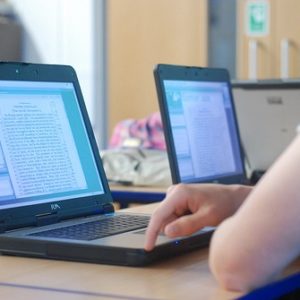Bring Your Own What, and Why?
This article was originally published by Bruce Dixon on the AALF.org Blog.
 At several recent conferences at which I have been speaking, there has been a lot of interest in the concept of students bringing their own computers, laptops, technology or devices…depending on how you like your acronym. I think it warrants further discussion.
At several recent conferences at which I have been speaking, there has been a lot of interest in the concept of students bringing their own computers, laptops, technology or devices…depending on how you like your acronym. I think it warrants further discussion.
On the surface it would seem natural that this is something AALF would fully support, and, in broad principle, of course we do. Our vision is for every child to have access to his or her own ‘personal portable computer’ to enable more powerful learning experiences..and, in part this is what is driving the current fascination with BYO. However, I fear there is much more to this than meets the eye.
First, there is motivation. There is no question that much of this discussion has been led by the dramatic increase in some demographics, with students buying their own various pieces of technology. The obvious question becomes why should it remain as something about which the school makes the decision? The second driver that is motivating this idea is the significant cut in funding to schools that as happening in some countries, most notably the US. A number of school districts and states that have previously funded their 1:1 initiatives through state grants or district funding are now challenged on finding sustainable funding.
So then the question becomes, what will students bring?
As always, there are a few people always looking for the ‘next big idea”, so currently we are being overwhelmed by the pocket electronic whiteboards or iPads, but discussions usually include phones and any sort of gadget with a screen. Seems the last thing anyone wants to ask is, ‘What will they want to do with it?’ For one, I’m happy if at least there is some agreement that you want them to be able to do basic computing functions, such as easily construct ideas, knowledge, share thinking and at all times be creative.
Then there is the issue of implementation. Currently very few corporations allow their staff to ‘bring their own’ laptops…and they usually have 4 to 5 times the technical support; how will schools manage this? …aha, I hear you say…virtualization…well yes…and no. Costs are currently a serious issue and managing such an environment is still a challenge for most schools…however, yes, over time this may underpin an option; but I doubt it is viable at this time.
Other ‘small’ issues like low cost software licensing, dependable onsite 12 hour turnaround servicing, loaner machines, security, and the classroom management benefits of a homogenous operating environment also need to be addressed in real detail.
The principles on which AALF was founded and on which we have given advice for nearly 15 years still apply. At all times, our priority must be to ensure any 1:1 program provides for ALL students and can be sustained in the long-term and not just dependent on the whims and fancies of political, technological and policy leadership.
This has always been at the core of our recommendation for the co-funded and Shared Cost Model of funding. Our early experiences taught us, and many schools, that given that one of the benefits from an effective 1:1 program would be to provide 24/7 access, there is a reasonable expectation that parents should make some contribution for the 80% of the time their son or daughter could now use a laptop for personal use outside school. However, I’m not sure why we can now suddenly expect parents to pick up 100% of the cost…by bringing their own! Given the challenges many school leaders often raise about asking parents to make a small contribution to a co-funded model, it seems a little incongruous that simply relabeling the program with a three letter acronym will erase these concerns and address all the core principles that have to date underpinned the success of 1:1 worldwide.
Finally, there is the core issue of equity. You don’t solve a lack of funding by passing 100% of the cost to parents, and expect that to be a viable option for ALL parents. We currently DON’T have any problems with viability, sustainability or scalability with the thousands of 1 to 1 programs currently operating around the world…but I suspect we certainly will have with many of the BYO programs being considered.
We are most likely going to see a gradual shift of the responsibility for the provision of a personal portable computer for our students from schools to families, as costs come down further, and computers are commoditized even more. But it will take time for the most effective funding, implementation and management models to be developed, and I expect they will, for the most part, be blended models that provide for all the challenges I have outlined above.
Above all we must continually remind ourselves to not be distracted from our core purpose.
….and as always, I’m most interested in your thoughts…
Best regards,
Bruce.







0 Comments
Leave a Comment
Your email address will not be published. All fields are required.